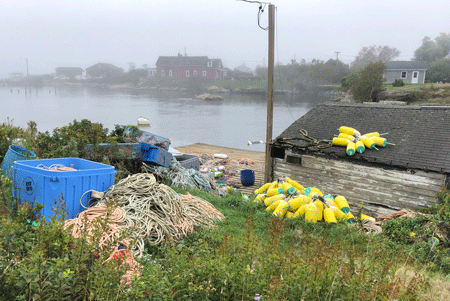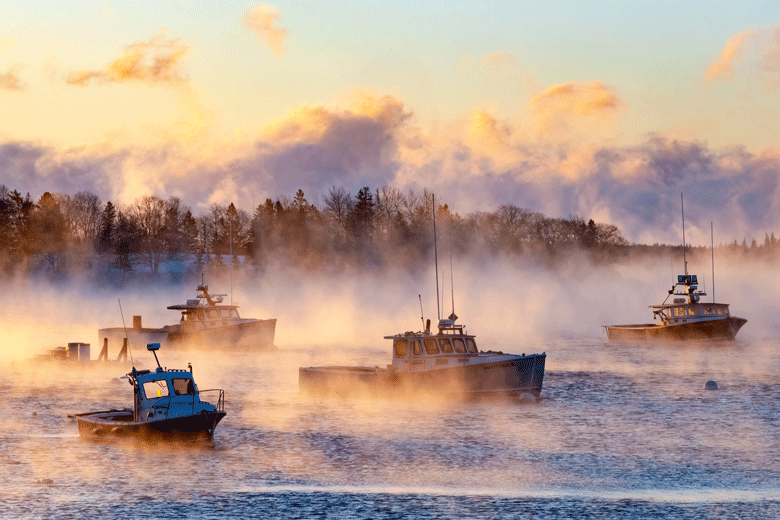In the late 1700s, the people who established what today is Belfast at the top of Penobscot Bay first built their homes on what locals call the East Side of town. A small cemetery, with crude slate gravestones, is all the evidence that remains of that foothold, since those early European arrivals soon moved to the shore west of the Passagassawakeag River.
The story that local historians tell is that the cool fog that perennially swept up the bay on the East Side nudged those residents to seek homes on the warmer, drier side of the harbor. To this day, on otherwise fine spring days, that fog flows up across the early settlement site and Route 1.
Fog is no stranger to much of the New England coast, but according to meteorologist Mike Clair of the National Weather Service in Gray, we in Maine have some bragging rights on the weather phenomenon—we’re one of three “hot spots” in the U.S., and one of three regions in the world that see daytime fog in the summer.
There are three high-incidence fog regions in the U.S.—the Pacific Northwest, the Southern Appalachians, and the Maine coast.
“Fog is saturated air,” Clair said. “When the dew point and the air temperature are the same, you often have fog.”
The Midcoast and Penobscot Bay regions are prime environments for fog, he said.
Clair was invited by the Penobscot Marine Museum to speak to a virtual gathering on “Fog Along the Maine Coast,” part of its “Fog & Ice” lecture series.
Meteorologists identify three kinds of fog, based on how it forms: radiation, steam, and advection.
Radiation fog occurs when “heat is lost into space on clear nights, cooling at the surface until moisture condenses.” This is common in summer and fall.

Steam fog, also known as Arctic sea smoke, occurs when very cold air moves from the land to over the ocean.
“Typically, when you would see it, it would be a cold wind blowing offshore,” Clair said. The cold, dry air picks up the moisture from the surface of the water. It can also occur over lakes.
But the bulk of our fog is the advection kind. This occurs when moist air from over warmer waters south of Maine moves over the cooler Gulf of Maine and condenses. The moist air also can originate over land southwest of the state in summer.
“This is one of the more common ones we see in the summertime,” Clair said. “These are the kinds of events where you’ll have it be foggy at the coast, then clear just a few miles inland.”
There are three high-incidence fog regions in the U.S., he said—the Pacific Northwest, the Southern Appalachians, and the Maine coast. Showing a world map, Clair noted that “Most of the world does not see fog in the daytime in the summer,” but those that do include the North Pacific (near Japan and Korea), the Arctic, and the Northwest Atlantic (Maine to Greenland).
Maine’s particular experiences with fog are influenced by its topography, Clair said.
“The Midcoast, PenBay regions have higher elevations along the coastline compared to the rest of the state,” he said, with some hills and mountains rising “as much as 1,500 feet. This allows air coming off the ocean to quickly cool and condense as it rises,” turning into fog.
Dynamic ocean currents in the Gulf of Maine also juice up fog here. The Nova Scotia, Eastern Maine Coastal, and Western Maine Coastal currents mix warmer and cooler waters. In the summer, water temperatures can range from the 60s and 70s in the middle of the Gulf of Maine, yet “In the Midcoast and Downeast, we hang onto those 40s and 50s,” again causing condensation of moist air.
Tides in Maine, ranging from 10- to 22-feet, also bring colder water to the surface, hastening that condensation.
“No matter how warm the Gulf of Maine gets in the summertime, you’re still going to get the tides changing water temperatures,” Clair said.
Showing a video of satellite imagery along New England, he explained how the Massachusetts and Nova Scotia coasts could be clear while Maine’s coast was socked in with fog, pushed up by prevailing winds and intensified by the warm, moist air meeting cool water.
And yet even in an era when satellites can capture this movement, fog is often a surprise.
“Models for marine fog are not very good at forecasting,” Clair said.





